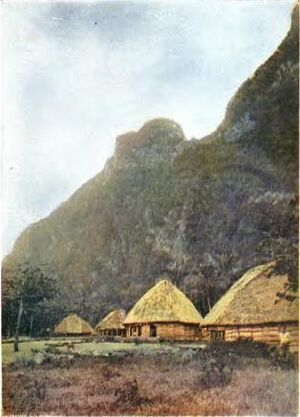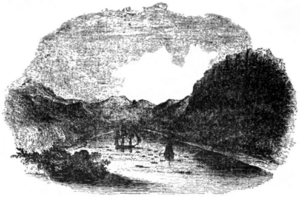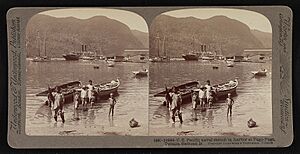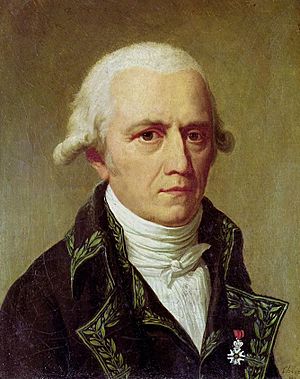History of American Samoa facts for kids

The beautiful islands of Samoa were first settled by people around 1000 BC. Many years later, in the 1700s, European explorers arrived. By the 1900s and 2000s, the islands became part of two main areas: Samoa (also called Western Samoa or Independent Samoa) and American Samoa (also called Eastern Samoa).
Contents
Early History of the Samoan People
The history of Eastern Samoa (now American Samoa) is closely linked to the history of Western Samoa (now independent Samoa). They share a common past.
The Tui Manu'a is a very old and important title in Samoa. Old stories and traditions from Samoa and Manu'a talk about a large network of Polynesian islands. These islands were once ruled by the Tui Manu'a leaders. These stories suggest that the Tui Manu'a were powerful and respected leaders in Samoa for a long time.
Legends say that the Tui Manu'a kings ruled a group of islands far and wide. This included Fiji, Tonga, and other smaller islands like Uvea, Futuna, Tokelau, and Tuvalu. People traded many goods between these islands. It's thought that the Tui Manu'a family became powerful by controlling this trade. They traded valuable items like special woven mats, whale ivory (called "tabua"), tools made from obsidian and basalt rock, red feathers for chiefs, and rare seashells.
The islands of Upolu and Savai'i were politically connected to 'Upolu island in what is now independent Samoa. Even today, all the Samoan islands are connected through the faamatai system. This is a system where chiefs lead. They are also connected through strong family ties. This system of chiefs and the customs of faasamoa (the Samoan way of life) began with two famous women chiefs, Nafanua and Salamasina. They were related.
Westerners Arrive in Samoa
In the 1700s, French explorers had a battle with islanders in Tutuila. Westerners unfairly blamed the Samoans for this. This gave Samoans a reputation for being fierce.
Later, in the early 1800s, missionaries from Rarotonga came to the Samoan islands. Then, in the 1830s, a group of Western missionaries arrived. They were led by John Williams from the London Missionary Society. They officially brought Christianity to Samoa. Less than 100 years later, the Samoan Congregationalist Church became the first independent church in the South Pacific. It was run by local people.
European and American Division of the Islands
The United States first became interested in Samoa in the mid-1800s. An American whaling trip in 1838 reported that Pago Pago Bay was valuable for trade. The U.S. wanted access to Samoan resources, especially coconut oil and copra (dried coconut meat).
During the American Civil War (1861–65), the Union blocked sugar and cotton exports from the South. This made the U.S. look for new places to get these goods. After the war, there was a big demand for cotton around the world. The South also needed to rebuild its economy. This made Samoa a good place for cotton farms.
At first, the U.S. Congress didn't want to make formal ties with Samoa. But they worried that Germany and Britain might take over the islands. This changed their minds. In 1872, the U.S. and Samoan chiefs signed an informal agreement.
Later, Germany and Britain planned to control Samoa. Because of this, a second agreement was signed. In 1878, the U.S. and Samoan leaders signed a treaty of friendship. This gave the U.S. the right to build a naval coaling station at Pago Pago Bay. It also allowed American ships to trade freely in other Samoan ports.
American Samoa was created after the Second Samoan Civil War. This happened because of an agreement between Germany, the United States, and the United Kingdom in 1899. This agreement was called the Tripartite Convention. The countries settled their rivalries with the Treaty of Berlin in 1899. Germany and the U.S. divided the Samoan archipelago (group of islands). The eastern Samoan islands became U.S. territories. They were later known as American Samoa. The U.S. officially took control of its part, including the important harbor of Pago Pago, the next year. The western islands are now the independent country of Samoa.
American Colonization of Samoa
Several chiefs from the island of Tutuila promised their loyalty to the United States. They gave the island to the U.S. in the Treaty of Cession of Tutuila in 1900. The last ruler of Manuʻa, the Tui Manuʻa Elisara, signed the Treaty of Cession of Manuʻa in 1904. This happened after some U.S. Navy trials. The United States officially approved these treaties in 1929.
After World War I, there was a movement in Western Samoa called the Mau movement. Western Samoa was then controlled by New Zealand. A similar movement started in American Samoa. It was led by Samuel Sailele Ripley, a war veteran from Leone village. In 1921, 17 chiefs from the American Samoa Mau movement were arrested and forced to do hard labor.
During World War II, many U.S. Marines were stationed in American Samoa. There were more Marines than local people. This had a big impact on the culture. Young Samoan men, aged 14 and older, were trained for combat by the U.S. military. Just like in World War I, American Samoans helped in World War II. They served as soldiers, medical staff, code workers, and helped repair ships.
How Race Affected Colonization
Some American officials had unfair ideas about Samoan people. They believed that Samoans were different because of their environment. The first governor of Samoa, B.F. Tilly, said Samoans were "still a patriarchal state." Other officials claimed Samoans "lacked character" and "seriousness." These officials thought that because the Samoan islands had a mild climate, people didn't have to work hard. They believed this stopped Samoans from developing traits that white Americans had.
However, American officials in Samoa also sometimes praised the native Samoans. In 1901, the governor called them "amiable" and "fine-looking and courtly." In 1904, they were described as a "gentle, kindly, simple-minded race [who] are easily governed." Samoans were often seen as being higher in status than Black people by these officials. In 1913, the Governor of Samoa said, "There is nothing about them to suggest the negro." He also praised the strong build of Samoan men.
Why the U.S. Was Slow to Make Samoa a State
Ideas about race played a part in why the U.S. government was slow to make Samoa a formal part of the United States. Under the U.S. Constitution, any new territory that became a state would give equal citizenship rights to its people. This meant non-white people in Pacific island territories would become full citizens.
Because of this, when Samoan chiefs asked President Ulysses S. Grant in 1873 to formally add Samoa to the U.S., Congress said no. The chiefs wanted protection from Britain and Germany. Racism was also a main reason why Congress was against expanding the Navy in the 1870s.
The Insular Cases and U.S. Control
After the Spanish-American War in 1898, the U.S. gained new territories like Puerto Rico and the Philippines. U.S. legal experts came up with a new way to govern these places. This new plan allowed the U.S. to control these territories without making them full parts of the country.
This system was first used by the Navy and then by Congress. Later, the Supreme Court made it legal with a series of rulings called the "Insular Cases" (from 1901 to 1922). These cases created a new policy. It mixed parts of U.S. expansion with colonial rule. It meant the U.S. could rule over these territories but not make them states. This was different from how the U.S. had added territories before. The Insular Cases have been used for all territories gained after 1898, including Samoa.
Before 1898, when the U.S. took over new lands, it usually planned for them to become states. But after the Spanish-American War, the "Insular Cases" changed this. They created a new way of doing things. The U.S. kept control over these territories but did not offer them a path to statehood.
The Supreme Court's Insular Cases also set an important rule. They said that being born in these new U.S. territories did not automatically make someone a U.S. citizen. This meant Congress had the power to decide if people in those territories would get citizenship.
After the first Insular Cases decisions, Congress decided that people living in these territories were "non-citizen nationals." Over time, the citizenship status of other territories changed through new laws. However, people born in American Samoa are still considered "non-citizen nationals" at birth. They do not automatically get U.S. citizenship.
In short, the Insular Cases rulings broke the automatic link between being born in a U.S. territory and becoming a citizen after 1898. Instead, Congress took on the power to give or not give citizenship to people in newly acquired territories.
American Samoa Today
After World War II, the U.S. Department of Interior tried to make American Samoa a more formal part of the U.S. This plan was called Organic Act 4500. But it was stopped in Congress. This was mainly thanks to the efforts of American Samoan chiefs, led by Tuiasosopo Mariota.
Because of the chiefs' efforts, a local law-making body was created. It is called the American Samoa Fono. It meets in the village of Fagatogo, which is the capital of the territory.
Over time, the governor, who was once chosen by the Navy, was replaced by a governor elected by the local people. The U.S. Congress has not passed a special law (called an Organic Act) for American Samoa. So, it's technically considered "unorganized." However, American Samoa governs itself under its own constitution, which started on July 1, 1967. The U.S. Territory of American Samoa is on the United Nations list of non-self-governing territories.
The islands have been careful not to separate from the U.S. in any way. The sea borders of American Samoa with New Zealand (which includes Tokelau, the Cook Islands, and Niue) have been set by treaties. Sea borders with Tonga and Samoa still need to be agreed upon.
Economy of American Samoa
Jobs on the island are divided into three main groups, each with about 5,000 workers. These groups are the public sector (government jobs), the tuna cannery, and other private businesses. There are only a few federal employees in American Samoa. There are no active military personnel, but there are some Army Reserve units. Most public sector employees work for the American Samoa Government. The StarKist cannery exports hundreds of millions of dollars worth of canned tuna to the United States.
See also
 In Spanish: Historia de Samoa Americana para niños
In Spanish: Historia de Samoa Americana para niños
- Outline of American Samoa
- History of the Samoan Islands





